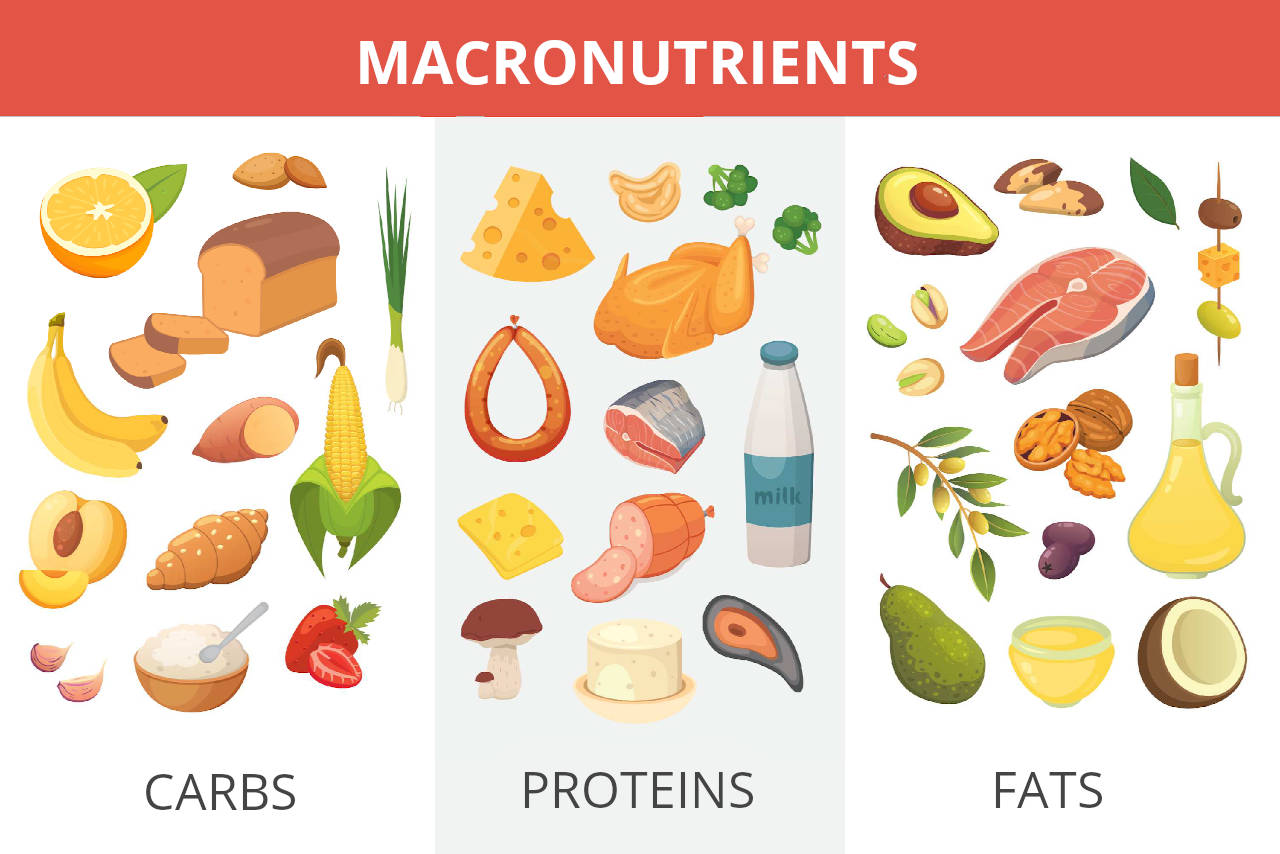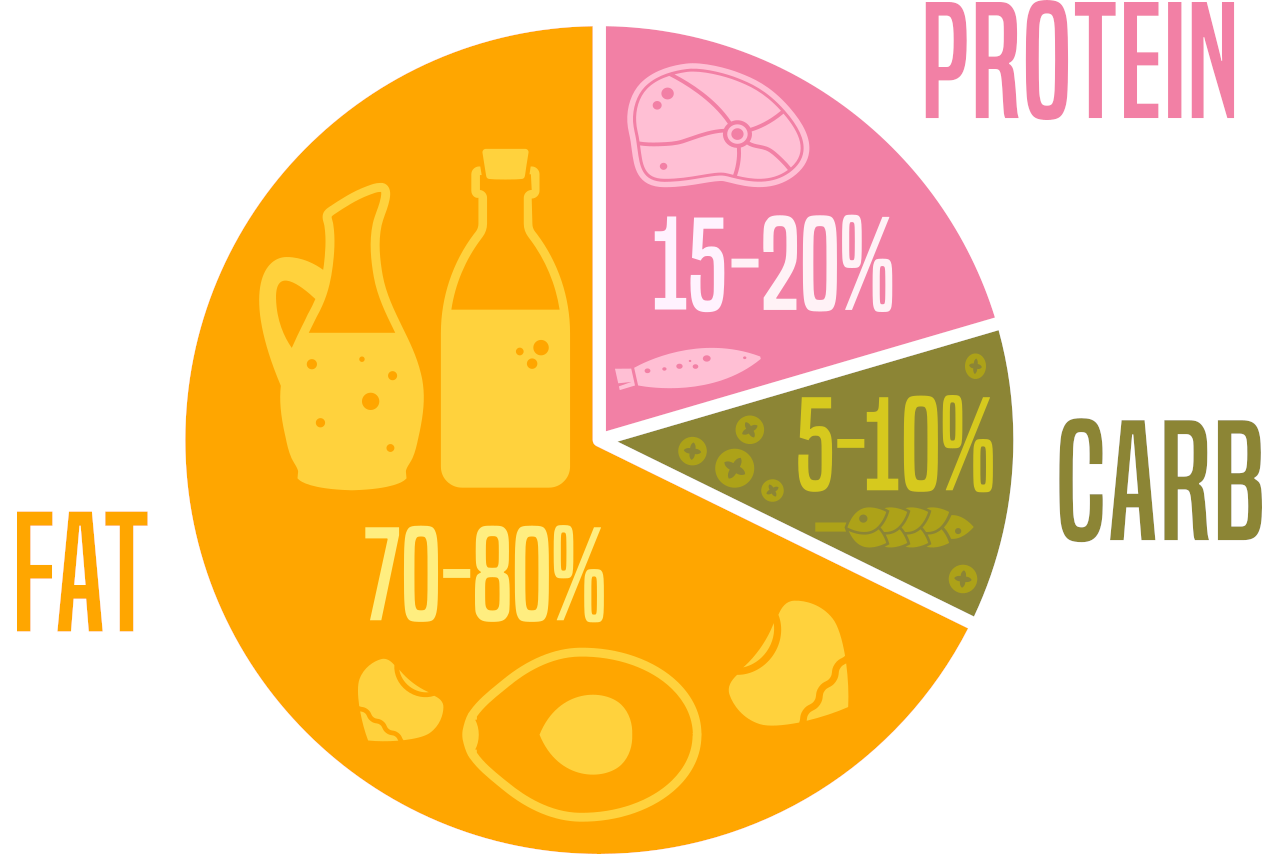Keto Calculator – Calculate Your Macros
Calculate the right macronutrient balance for keto using our keto calculator below. Enter your age, gender, height, weight, and activity level to get started.
Your Results:
| Carbs: | ? grams/day
|
|---|---|
| Protein: | ? grams/day
|
| Fat: | ? grams/day
|
Daily Calorie Allowance
| Total: | ? kcal/day
|
|---|---|
| From Carbs: | ? kcal/day
|
| From Protein: | ? kcal/day
|
| From Fat: | ? kcal/day
|
On this page:
- Keto Calculator
- What is Ketosis?
- How To Calculate Keto Macros
- Step One: Calculate Calorie Intake
- Step Two: Calculate Macro Breakdown
- Step Three: Calculate Daily Macro Needs
- Counting Keto Macros For Weight Loss
- Net Carbs
- Keto Macros and Athletes
- Keto-Flu
- Low-Carb Macros
- Health Benefits of Counting Macros for a Ketogenic Diet
- References
What is Ketosis?
By now, most people have heard of the ketogenic, or keto, diet. This high-fat, low-carbohydrate, and moderate protein diet has a strong following, but not many know how it actually works to aid in weight loss.
The keto diet gets its name because because following this eating pattern, your body enters ketosis.
Under normal circumstances, the human body uses glucose, or carbohydrates, as an energy source. However, if there are not enough carbohydrates available, the body uses fat as an energy source instead. Ketosis is a metabolic process where the body burns fat for energy instead of glucose.[1]
The original ketogenic diet that was used to control seizures was very low in carbohydrates (<50 grams a day), with a large proportion of daily calories coming from fat instead.[2]
Since the keto diet has increased in popularity, variations of this diet have emerged that are easier for most people to follow. The term is now used to loosely describe a diet with the main characteristic being that the diet is very low in carbohydrates, moderate in protein, and high in fat (2).
A recent meta-analysis from the Journal Reviews in Endocrine and Metabolic Disorders found that individuals following the ketogenic diet had increased weight loss along with reductions in waist circumference, body mass index, blood pressure, and cholesterol.[3]
How To Calculate Keto Macros
All food is composed of macronutrients and micronutrients.
Vitamins and minerals that supplement your body to support your overall health are considered micronutrients. Macronutrients are the elements in food that supply your body with energy to fuel you through the day. The three macronutrients are carbohydrates, protein, and fat.

A proportion of the calories that you consume each day will come from carbohydrates, protein, or fat. Each of these macronutrients play a vital role in your body’s physiological functions beyond just supplying energy.
As mentioned above, carbohydrates are typically the main energy source for the body. This includes all physical activity, from intense exercise to sitting at your desk typing.
Protein is important for muscle growth and maintenance, while fat is a vital component of cell membranes and also aids in the absorption of certain vitamins and minerals.
There are variations to the keto diet, however typically, these diets require that only about 5% of your calories come from carbohydrates.
The normal macronutrient distribution is 45-65% of calories coming from carbohydrates, 10-35% coming from protein, and 20-35% coming from fat.
As mentioned previously, there are several variations of the ketogenic diet. In general, the macronutrient recommendations for this diet are:[4]
- Carbohydrates: 5-10%
- Protein: 15-20%
- Fat: 70-80%

Step One: Calculate Calorie Intake
The first step to calculate keto macros is to determine how many calories you require on a daily basis. Your calorie needs are based on your total daily energy expenditure (TDEE), which is calculated by multiplying your basal metabolic rate (BMR) by an activity factor.
TDEE = BMR × activity factor
This can be easily calculated by using a TDEE and BMR calculator that accounts for your age, gender, height, and weight.
Your TDEE is an estimate of how many calories you should eat each day to maintain your current weight. If you are trying to lose weight, you will need to create a calorie deficit. On the other hand, if your goal is to gain lean muscle, you will need to increase your calorie consumption.
Step Two: Calculate Macro Breakdown
Once you determine your required daily calorie intake, the next step is to determine which proportion of calories each macronutrient should account for. If you are counting macros for a ketogenic diet, this means that roughly 5% of calories will come from carbohydrates, 25% from protein, and 70% from fat.
If you are counting macros for a ketogenic diet, the percentages from each macronutrient can vary depending on what works best for you. For purposes of this example, we will use roughly 5% of calories from carbohydrates, 25% from protein, and 70% from fat.
For example, a moderately active, 5-foot 5-inch, 35-year-old female that weighs 140 pounds would use the following calculations to determine her macro needs for a keto-based diet:
Based on the TDEE calculator using the Mifflin St Jeor BMR formula, the total daily energy expenditure would be 2,063 calories. (BMR = 1,331 × 1.55 activity factor)
The next step is to multiply this by the keto macro percentages.
2,063 × 0.05 = 103 calories from carbohydrates
2,063 × 0.25 = 516 calories from protein
2,063 × 0.70 = 1,444 calories from fat
Step Three: Calculate Daily Macro Needs
Finally, you can convert the calories of each macronutrient to grams by dividing the calorie count by the number of calories per gram for each.
| Macronutrient | Calories per Gram |
|---|---|
| Fat | 9 kcal |
| Carbohydrate | 4 kcal |
| Protein | 4 kcal |
Continuing the example above:
103 ÷ 4 = 26 grams of carbohydrates
516 ÷ 4 = 129 grams of protein
1,444 ÷ 9 = 160 grams of fat
As you can see, the keto diet requires a much higher fat content than the typical diet that most people follow. While it may seem counterintuitive to eat more fat to lose weight, studies have shown this diet can have a number of health benefits, including weight loss and improved metabolic markers.[4]
Despite these benefits, the keto diet can be difficult to follow and is not right for everybody. It is best to consult with a healthcare provider before starting this diet.
Counting Keto Macros For Weight Loss
Counting macros to follow a very low-carbohydrate ketogenic diet can also aid in weight loss. Not only can the ketogenic diet reduce body weight, fat mass, and visceral fat, this can occur while still preserving muscle mass, muscle strength, and resting metabolic rate.[5]
On top of this, the ketogenic diet can also help decrease hunger and appetite, which can increase adherence to this diet.[5]
Despite this being a high-fat diet, studies have found that individuals following a ketogenic diet achieve a greater weight loss than those assigned to a low-fat diet in the long term.[6]
How To Calculate Keto Macros For Weight Loss
Following a ketogenic diet can have a multitude of health benefits. However, the results will not be the same for everybody and the macronutrient content needs to be individualized for each person based on their daily calorie needs.
If you do choose to increase your weight loss by reducing your total calorie intake in addition to adopting keto, then you’ll need to use the lower calorie values when calculating your macros.
In the example of the woman above, we calculated that she would need 2,063 calories daily to maintain her current weight. Her keto macros were then estimated based on these calorie needs.
However, if this same woman was aiming to lose a pound a week, she would need to reduce her daily calorie intake by about 500 calories each day. Therefore, her daily calorie needs would be 1,563 calories per day.
Based on these calorie needs and using the same macronutrient distribution as earlier, her macro counts would then be:
1,563 × 0.05 = 78 calories from carbohydrates
1,563 × 0.25 = 391 calories from protein
1,563 × 0.70 = 1,094 calories from fat
The calculated calories can then be converted to grams of each macronutrient by dividing the calorie count by how many calories each macronutrient contains.
78 ÷ 4 = 20 grams of carbohydrates
391 ÷ 4 = 98 grams of protein
1,094 ÷ 9 = 122 grams of fat
Refer to the chart above to get the calories per gram.
Net Carbs
We can’t discuss very low-carbohydrate diets without going over net carbohydrates.
When you consume carbohydrates, they are broken down into various sugar components, such as glucose and fructose. Then, the body absorbs them in the small intestine.
Your body can’t break down some carbohydrates, like fiber and sugar. Instead of being absorbed, fiber is fermented in the large intestine. Sugar alcohols are only partially broken down and absorbed.
Some experts suggest that most fiber and sugar alcohols can thus be subtracted from the total carbohydrates of a food, and argue that the “net carb” value should be used instead. Net carbs are sometimes called “impact carbs,” “effective carbs,” or “net effective carbs.”
So, how do you calculate net carbs? You can subtract the amount of dietary fiber in grams and half of the sugar alcohol in grams from the total carbs, or, you can use our net carb calculator.
Keto Macros and Athletes
Carbohydrates are known for being the main energy source for physical activity. However, there is increasing interest in low carbohydrate and keto diets in relation to athletic performance.
A review of research shows that there is evidence to both support and go against the use of a keto diet in athletes.
For example, one study found that after 12 weeks of following a keto diet where 6% of calories were derived from carbohydrates, athletes had improved body composition, fat oxidation during exercise, and specific performance measures relevant to competitive endurance athletes.[7]
This is compared to athletes that consumed a high-carbohydrate diet where 65% of calories came from carbs.
On the other hand, it should be noted that there are other trials that fail to show performance benefits from following a low-carb diet, and in some instances, can be detrimental to performance.[8]
For instance, in some studies, participants reported more subjective fatigue or decreased ability to train on these low-carb regimens.[8] Therefore, choosing a ketogenic diet in athletes needs to be individualized and should be done so with the assistance of a professional.
Keto-Flu
One of the biggest challenges to following a ketogenic diet is long-term adherence to a low-carbohydrate intake. In roughly the first week of adopting keto, many individuals develop symptoms that have been referred to as the “keto flu.”
This group of symptoms includes headache, brain fog, fatigue, irritability, nausea, difficulty sleeping, and constipation.[9]
These symptoms are thought to be the body’s response as it adapts to a lower carbohydrate diet and becomes reliant on ketones for energy.
This is also referred to as “keto-induction.” Over time as these side effects resolve, this is termed “keto-adaptation” when a stable level of ketones are reached.[9]
Followers of the keto diet report that you can combat the symptoms of keto flu by staying hydrated, replacing electrolytes, getting plenty of sleep, avoiding strenuous activities, eating enough fat, and cutting out carbs slowly over time.[9]
Low-Carb Macros
When choosing foods for a low-carb diet, you will mainly be substituting carbohydrate macros with fat macros. It is crucial to still choose healthy fat substitutes that fit your macro percentages.
In addition, you should try to pick high fiber, low-carbohydrate fruits, vegetables, and whole grains over processed foods high in sugar alcohols.
Low-Carb Foods
Healthy low-carb options for a ketogenic diet include:
Fish: Many types of fish are carb-free or very low in carbs and contain healthy omega-3 fatty acids. Salmon, an extremely healthy fish, has zero carbs. Shellfish like oysters and clams have only 3-4 grams of carbs per serving.
Meat and Poultry: Meat and poultry do not contain any carbs and make up a large proportion of low-carb keto diets. In addition, these are rich in high-quality protein and nutrients like iron and vitamin B-12.
Eggs: Eggs are a great source of protein. For one, they contain all of the essential amino acids your body needs for muscle building. Eggs are a great choice for a low-carb diet since they contain less than 1 gram of carbohydrates per egg.
In the past, experts thought that consuming eggs would increase cardiovascular risk factors because of their cholesterol content.
However, a recent 2020 study from the Journal of the American Heart Association found no significant association between egg consumption and mortality in US adults.[10] Eggs are also nutrient-filled and contain Vitamins A, D, E, B vitamins, zinc, biotin, choline, and iron.
Non-Starchy Vegetables: The net carbs in non-starchy vegetables are low since they contain a high amount of fiber.
Non-starchy vegetables include things like cauliflower, broccoli, avocado, lettuce, spinach, kale, and peppers. Starchy vegetables, like potatoes, contain a high-carb count and should be avoided or limited on a keto diet.
Yogurt: Both plain Greek yogurt and cottage cheese contain around 5-7 grams of carbs per serving. These dairy options also contain high protein, which can also reduce appetite. Plus, many yogurts contain probiotics that enhance gastrointestinal health.
Nuts and Seeds: Nuts and seeds are low-carb options that are high in healthy fat and fiber. Almonds, brazil nuts, pecans, and walnuts contain only about 1-2 grams of carbohydrates per serving.
Flaxseeds, chia seeds, and sesame seeds have about 1-3 grams of carbohydrates per serving. Nuts and seeds make great snacks on their own or as additions to trail mix or even salads.
Berries: Unfortunately, most fruits contain too much natural sugar and carbs to include in a low-carb keto diet. However, berries are one fruit that has a lower carb count and high fiber content.
For example, raspberries have about 4 grams of net carbs per serving and 9 grams of total carbs per serving.
Olive Oil: Olive oil has long been known to promote heart health. When increasing the fat macros in your diet, this is one of the healthier options to choose.
Since it is a pure fat source, olive oil contains no carbs. Plus, extra-virgin olive oil is high in monounsaturated fats and antioxidants that promote cardiovascular health.
Health Benefits of Counting Macros for a Ketogenic Diet
Counting macros can be an effective way to maintain a healthy eating pattern without being on a specific diet.
Studies have found that a ketogenic diet can aid in weight loss In addition and can improve glycemic control in individuals with type 2 diabetes.[2][11]
The Ketogenic Diet For Type 2 Diabetes
Following a ketogenic diet has been found to help improve the health of people with diabetes.
A study from Nutrition and Metabolism demonstrated that a low-carbohydrate, ketogenic diet led to greater improvements in blood sugar control and more frequent medication reductions or eliminations than a low calorie, low glycemic index diet in individuals with type 2 diabetes.[11]
A 2020 meta-analysis found a ketogenic diet superior to control diets for weight reduction, glycemic control, and an improved cholesterol profile.[12] This illustrates how counting macros to adhere to a low-carbohydrate diet can be a useful adjunct in treating type 2 diabetes.
Risks Associated with a Ketogenic Diet
Despite there being good evidence to support a ketogenic diet being beneficial to some aspects of health, there is also evidence to show that this does not come without risks.
A 2021 review of studies showed that very low carbohydrate diets can increase LDL cholesterol. Also, if there is not a focus on consuming healthy fats more so than unhealthy fats, there can be an increased risk for cardiovascular disease, cancer, diabetes, chronic kidney disease, and Alzheimer’s disease.[2]
Before deciding if you should follow a ketogenic diet, you should discuss your goals with a dietitian or physician.
Similar Nutrition Calculators
References
- Veech, R. L., The therapeutic implications of ketone bodies: the effects of ketone bodies in pathological conditions: ketosis, ketogenic diet, redox states, insulin resistance, and mitochondrial metabolism, Prostaglandins, Leukotrienes and Essential Fatty Acids, 2004, 70(3), 309-319. https://pubmed.ncbi.nlm.nih.gov/14769489/
- Crosby, L., Davis, B., Joshi, S., Jardine, M., Paul, J., Neola, M., & Barnard, N. D., Ketogenic Diets and Chronic Disease: Weighing the Benefits Against the Risks, Frontiers in Nutrition, 2021, 8, https://doi.org/10.3389/fnut.2021.702802
- Castellana, M., Conte, E., Cignarelli, A., Perrini, S., Giustina, A., Giovanella, L., et al., Efficacy and safety of very low calorie ketogenic diet (VLCKD) in patients with overweight and obesity: A systematic review and meta-analysis, Reviews in Endocrine and Metabolic Disorders, 2020, 21(1), 5-16. https://link.springer.com/article/10.1007/s11154-019-09514-y
- Zhu, H., Bi, D., Zhang, Y., Kong, C., Du, J., Wu, X., Wei, Q., & Qin, H., Ketogenic diet for human diseases: the underlying mechanisms and potential for clinical implementations, Signal Transduction and Targeted Therapy, 2022, 7(1), https://doi.org/10.1038/s41392-021-00831-w
- Casanueva, F.F., Castellana, M., Bellido, D., et al., Ketogenic diets as treatment of obesity and type 2 diabetes mellitus, Reviews in Endocrine and Metabolic Disorders, 2020, 21(3), 381-397. https://link.springer.com/article/10.1007/s11154-020-09580-7
- Bueno, N. B., de Melo, I. S. V., de Oliveira, S. L., & da Rocha Ataide, T., Very-low-carbohydrate ketogenic diet v. low-fat diet for long-term weight loss: a meta-analysis of randomised controlled trials, British Journal of Nutrition, 2013, 110(7), 1178-1187. https://www.cambridge.org/core/journals/british-journal-of-nutrition/article/verylowcarbohydrate-ketogenic-diet-v-lowfat-diet-for-longterm-weight-loss-a-metaanalysis-of-randomised-controlled-trials/6FD9F975BAFF1D46F84C8BA9CE860783
- McSwiney, F. T., Wardrop, B., Hyde, P. N., Lafountain, R. A., Volek, J. S., & Doyle, L., Keto-adaptation enhances exercise performance and body composition responses to training in endurance athletes, Metabolism, 2018, 81, 25-34. http://ketogevitysa.co.za/wp-content/uploads/2020/12/Journay-of-metabolism-Keto-adaption-enhances-performance-in-athletes-.pdf
- Bailey, C. P., & Hennessy, E., A review of the ketogenic diet for endurance athletes: performance enhancer or placebo effect?, Journal of the International Society of Sports Nutrition, 2020, 17(1), 1-11. https://link.springer.com/article/10.1186/s12970-020-00362-9
- Bostock, E. C. S., Kirkby, K. C., Taylor, B. V., & Hawrelak, J. A., Consumer Reports of “Keto Flu” Associated With the Ketogenic Diet, Frontiers in Nutrition, 2020, 7, https://doi.org/10.3389/fnut.2020.00020
- Xia, P. F., Pan, X. F., Chen, C., Wang, Y., Ye, Y., & Pan, A., Dietary Intakes of Eggs and Cholesterol in Relation to All‐Cause and Heart Disease Mortality: A Prospective Cohort Study, Journal of the American Heart Association, 2020, 9(10), e015743. https://www.ahajournals.org/doi/full/10.1161/JAHA.119.015743
- Westman, E. C., Yancy, W. S., Mavropoulos, J. C., Marquart, M., & McDuffie, J. R., The effect of a low-carbohydrate, ketogenic diet versus a low-glycemic index diet on glycemic control in type 2 diabetes mellitus, Nutrition & Metabolism, 2008, 5(1), 1-9. https://nutritionandmetabolism.biomedcentral.com/articles/10.1186/1743-7075-5-36
- Alarim, R. A., Alasmre, F. A., Alotaibi, H. A., Alshehri, M. A., & Hussain, S. A., Effects of the Ketogenic Diet on Glycemic Control in Diabetic Patients: Meta-Analysis of Clinical Trials, Cureus, 2020, 12(10), https://www.ncbi.nlm.nih.gov/pmc/articles/PMC7641470/


